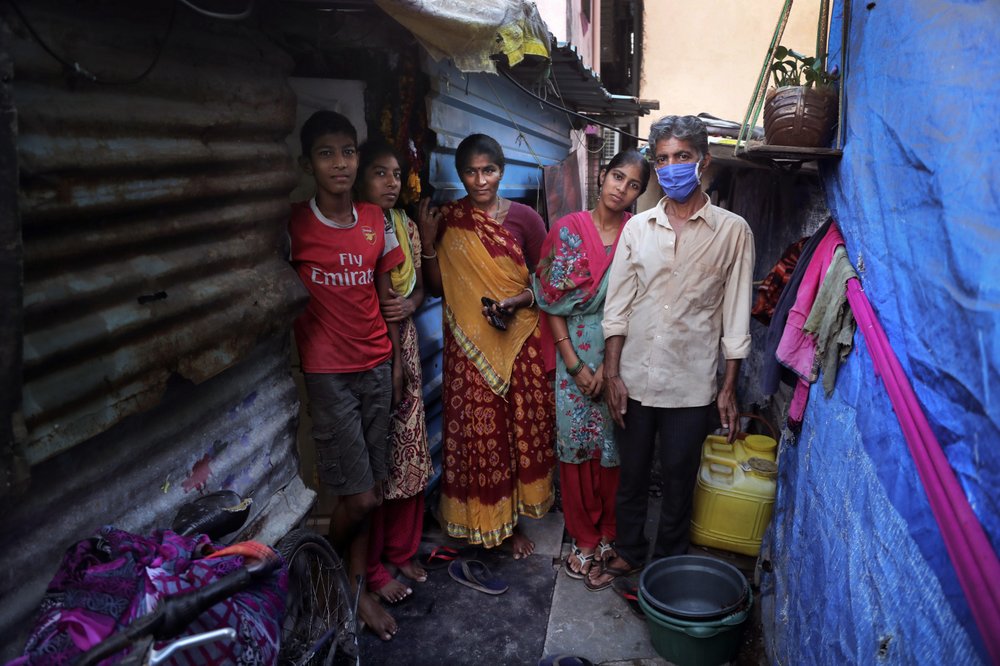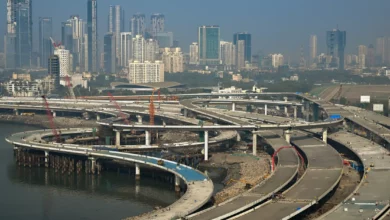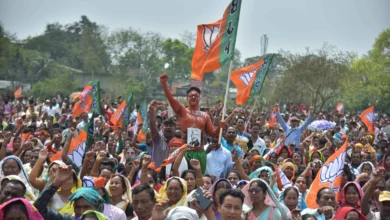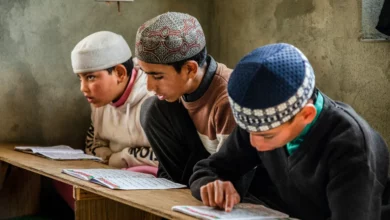
The street peddler watched the prime minister’s speech on a battered TV, with her family of five crowded around her in a one-room house with no toilet and no running water. It’s squeezed into a Mumbai shantytown controlled by an obscure Mumbai organized crime family.
Mina Jakhawadiya knew that outside, somewhere in India, the coronavirus had arrived, wending its way through this sprawling nation of 1.3 billion people. But the invisible danger seemed far away.
Then suddenly it wasn’t.
“Every state, every district, every lane, every village will be under lockdown” for three weeks, Prime Minister Narendra Modi told the nation on March 24, giving India four hours’ notice to prepare. “If you can’t handle these 21 days, this country and your family will go back 21 years.”
As governments around the world try to slow the spread of the coronavirus, India has launched one of the most draconian social experiments in human history, locking down its entire population — including about 176 million people who struggle to survive on US$1.90 a day or less. Modi’s order allows Indians out of their homes only to buy food, medicine or other essentials. No going to work. No school. No playgrounds.
India’s handling of the lockdown and the ever-spreading virus is a test for the developing world, offering clues to how countries from Bangladesh to Nigeria can fight COVID-19 without forcing their poorest citizens into even worse hunger and further destitution.
While India’s economy has boomed over the past two decades, pulling vast numbers out of extreme poverty, inequality also has grown.
Those near the top can hunker down in gated apartment complexes, watching Bollywood movies on Netflix and ordering food deliveries online. But not Jakhawadiya, who makes a living selling cheap plastic buckets and baskets with her husband on the streets of Mumbai.
For her, the order means 21 days in a six-by-nine-foot room with five people, no work, a couple days of food and the equivalent of about $13 in cash.
She looked at Modi speaking on their little television, spattered with stickers left over the years by one child or another.
“I am so afraid,” she thought.
______
March 27
Across India
The reasons for the lockdown are clear.
While India had only 536 confirmed coronavirus cases and 10 deaths when Modi gave his speech, it’s also one of the most crowded places on Earth, a nation where social distancing is impossible for millions. The risk is that it could hopscotch from the Himalayas to South India, ravaging cities and villages. Mumbai, for instance, has a population density of 77,000 people per square mile — nearly three times higher than New York City, which crowding helped turn into one of the world’s deadliest epicenters.
Then there’s India’s medical system. Except for private health care for those who can afford it, the medical system barely functions across wide swathes of the country. Public hospitals, especially outside major cities, often have limited supplies, questionable cleanliness and third-rate doctors.
Very few people have been tested, so the true scale of the outbreak is unknown. If India’s hospital system were overrun by COVID-19 cases, it could collapse in days, leaving untold numbers to die.
As a result, many experts say Modi had to act as he did to buy time to prepare.
The lockdown means India has “probably pushed out the epidemic peak by three to eight weeks,” said Ramanan Laxminarayan, an epidemiologist and economist who directs the Center for Disease Dynamics, Economics and Policy in Washington.
But that logic means little for Indians at the bottom of the economic ladder. For these people — for Jakhawadiya in Mumbai, for a maid walking to her home village in the north, for a watchman bicycling his way across the country — three weeks can be an eternity.
“If they stopped the lockdown for just a few days then I could go into town and earn some money,” said Paresh Talukdar, a beggar who supports a family of five in India’s far northeast state of Assam with food supplies down to almost nothing. “One or two days (of lockdown) would be OK, but 21 days is a very long time.”
Now 60, Talukdar lost his left leg and hand more than 30 years ago in a fight over family land. In normal times, he rides a bus from his tiny village to the nearest city, where there are enough people to make a living begging. Most days bring him about $2.50.
But now there’s no bus to take, and few people out on the streets anyway.
Already, he says, the ever-growing hunger has made it hard to sleep. “Thoughts are always coming into my mind, like: What’s going to happen tomorrow?”
_________
March 29
Lucknow, north India
For five days after the lockdown began, in a city in the north Indian plains, the maid wondered what she should do.
Ramshri Verma lives in a shantytown on the fringes of Lucknow, a noisy, chaotic city of nearly four million people. On the morning after Modi’s speech, she went to the home where she has worked for the past two years.
“I didn’t know what they meant by a ‘lockdown,’” she said.
She knocked. Her employers shouted at her through the closed door.
“They told me to come back after 21 days,” Verma said. They also told her she wouldn’t be paid for those days.
She walked home, stopping at a few small stores. She bought rice, cooking oil, spices and lentils, basic staples for many Indians. That left her with 300 rupees — about four dollars — for her, her husband and their two children.
Then the family waited. They don’t own a television, so the children bickered about who could watch videos on their only phone.
By March 29, the family was out of food and there was only one place to go: back to the ancestral village where she and her husband were raised. That morning, with bus and train networks shut down, they joined the swarms of migrants who spilled out of cities to walk, sometimes for hundreds of miles, to their home villages.
It was an epidemiologist’s nightmare — and the last thing India needed as it struggled to stop the coronavirus from spreading. The numbers already were rising with worrying speed, reaching 1,024 cases and 27 deaths.
For Verma, home was some 90 km (55 miles) away in Sanjrabad, a tiny grid of streets surrounded by lush fields of sugarcane.
“There were thousands of people who were walking,” she said. “Along the way I met other people who came from my village and we started to walk together.”
The children were tired. Their feet hurt. They cried.
But she and her husband pushed them on.
Late that night, they reached the edge of Sanjrabad and thought they would go home for dinner. But the village leader came out to stop them.
“’You could be infected with the virus,’” he said, ordering them into quarantine in the village school.
There were no medical checks, and no police to enforce the order. But in the ways of rural India, it’s hard to refuse a village head.
Minutes later, everyone was locked inside.
___
March 31
Prayagraj, central India
The balloon seller just couldn’t get used to the lockdown.
“There is a strange stillness in our neighborhood since all this started,” said Rajesh Dhaikar.
Normally, he has a small stall in a nearby market, selling plastic bursts of red and blue and yellow one at a time, and rarely earning more than $2.50 a day. His wife, Suneeta, makes about $20 a month cleaning homes.
They have two rooms with a thatch roof covered with a blue tarpaulin. In the rainy season, water seeps in. The single light dangles from a cord.
Suneeta sleeps on the only bed. The five kids sleep on the floor lined up under blankets. Rajesh sometimes sleeps on the sidewalk out front, stretched out on a cart handmade from wooden planks and bicycle tires.
They have a bank account — with about $6.50 in it.
Nearly half the family’s income comes from their 17-year-old son Deepak, a thin, wiry boy with carefully combed hair and a teenager’s bored slouch. He dropped out of school after 7th grade and now makes about $40 a month working in a neighborhood tea stall. One day, he says, he’ll have his own stall.
When he can, Deepak slips outside to play cricket with friends. They scatter when the police come by, then return to their match a few minutes later.
His mother doesn’t like it. Suneeta doesn’t completely understand coronavirus, but she knows getting near other people can kill you.
“What else do you expect from a 17-year-old? He doesn’t listen to anyone and does whatever he wants,” she said.
___
April 3
Along Highway 48, western India
The watchman confronted the lockdown by buying a bicycle.
A skinny, soft-spoken 30-year-old with a carefully trimmed beard, Mohammed Arif was working as a guard at a Mumbai apartment building when he got a call on April 1. His 60-year-old father had suffered a brain hemorrhage, and was battling for his life in a hospital in Rajouri, a small town in the Himalayan foothills of Kashmir.
By then the lockdown had begun. Buses and trains sat idle. Flights had been cancelled, though he couldn’t have afforded a ticket anyway.
So Arif bought a Hero Ranger bicycle with fading purple paint from a fellow guard for about eight dollars, and set off the next morning with the equivalent of $12 in his pocket and a small rucksack with clothes, a loaf of bread and a water bottle.
His destination was 1,300 miles (2,100 kilometers) away.
“What choice do I have?” Arif said in a phone call at the end of his first day, when he still had more than 2,000 kilometers to go. “He has no one else.”
“Poor people suffer always and face tribulations. There’s no escape,” he said. “But at least my conscience is clear.”
Repeatedly, Arif stumbled onto people who helped him. In one town, a man running a tiny tire-repair shop offered him chicken and rice. A couple days later, a truck driver shared his lunch.
One of the biggest surprises: the police. The Indian poor often fear the police, who regularly demand bribes and beat people with their bamboo staffs. But while police stopped Arif a few times, they always let him pass once he told his story.
He sleeps near gas stations, because they are well lit, or at closed roadside restaurants. Sometimes, he stops when he simply can go no further.
“I reached a highway village last night and wanted to rest there until dawn. But the villagers told me to go away,” he said in one early morning phone call. “They said people might harm me, or even kill me.”
He quickly left and kept pedaling until he reached a small forest.
“I stopped and I’m now waiting for sunrise,” he said.
A few days later, luck won out. After 450 kilometers (300 miles) of cycling, India’s paramilitary police picked him up and, in a public relations display, arranged trucks to take him to the hospital where they were transferring his father.
He brought the bicycle with him.
_______
April 6
Sanjrabad, north India
For three days, Ramshri Verma and the other migrants remained locked in the school in her ancestral village. Local officials brought them nothing. The group begged passersby for food and water.
Finally, a team of doctors escorted by police opened the school’s doors. The doctors stood well back, talking to the group from a distance.
For Verma and her family, quarantine was over.
The doctors didn’t check anyone’s temperatures or run any tests. “They only told us that we should wash our hands and then we were told to go home,” she said.
The maid and her family moved into her father in-law’s house.
At first it felt like being released from prison, but it quickly became clear things wouldn’t be much easier.
Because they weren’t registered in the village, they were not eligible for the food rations that local officials were occasionally distributing for the poor. They are surviving on handouts from family of flour and rice, and a few dollars her husband earned working as a laborer for a couple of days.
The neighbors avoid them, especially when they walk to the communal tap to get water, fearing they carry coronavirus.
She keeps her children at home. When they aren’t watching phone videos, they join her on the roof.
“We can see a lot of things from the roof: cows, goats, buffaloes,” said Verma.
The children also watch the village kids play. But they never join in.
________
April 10
Mumbai, western India
Things were growing tense in the Jakhawadiya house. So many days locked together in a tiny space. So little to do. They watched TV — state television was rebroadcasting The Ramayana, an iconic, 78-episode series based on the Hindu epic that was wildly popular in the 1980s — but that eats up only so much time.
The gangsters who run the neighborhood had come by a few times for their $65 monthly rent, which was due on April 1. But the family didn’t have the money.
Mina Jakhawadiya was worried. The family was hungry, though aid groups were distributing enough food every few days to keep the worst hunger at bay.
“I know we are facing bad days ahead,” said Jakhawadiya, a fierce-eyed 47-year-old woman who, like many in India’s vast slums, is a force of will. She knew how to arrange for a daughter’s heart surgery and can feed her family on her minuscule profits. But she’s never faced anything like this.
When things grew especially difficult, it was her quiet husband, Ramesh, who defused the tension, joking and roughhousing with the kids.
“I saw him laughing today,” Mina said in early April, clearly surprised. “The kids were laughing too. I felt really good inside but I have this perpetual fear of what might happen next. Today we have a roof to sleep under, but what if tomorrow we’re evicted? What if we have no food?”
She refuses to watch the news. By April 10, coronavirus cases had reached 7,598, with 226 deaths.
“There is no good news right now,” she said. “All they talk about on the television is people dying.”
________
April 12
Prayagraj, central India
The teenage tea-stall worker, Deepak Dhaikar, was increasingly unhappy.
“The lockdown was not the right decision,” grumbled Deepak, whose friends no longer came out to play cricket. “The rich can survive even if the lockdown stretches for a year, but what will the poor do?
Without even a television, he had started going to bed earlier, and waking up later. One day was blurring into the next.
But sometimes, a 17-year-old who knows the streets can be useful.
When a call came that his grandparents had run out of bread, his mother turned to Deepak.
His grandparents live a few miles away. She gave him a half-kilo of flour and sent him out into the streets. He jogged through roads, alleys and fields, dodging police checkpoints or talking his way through them, until he reached his grandparents and delivered the food.
But like Deepak, many in India were growing frustrated as the lockdown stretched on.
On April 10, as cases kept climbing, hundreds of migrant workers desperate to return home took to the streets in the western city of Surat, burning cars. Police arrested at least 80 people.
Two days later, outside a wholesale vegetable market in the north Indian city of Patiala, police stopped a car of Sikh men, who carry swords as a declaration of their faith. When the police refused to let the men in without curfew passes, the Sikhs injured three policemen, chopping off the hand of one.
Across the country, small towns and villages had started closing themselves off, trying to keep the virus away.
“No outsiders allowed,” said a sign on a makeshift barricade in a village north of New Delhi, where groups of men demanded identification from passersby.
An hour’s drive away, in the barricaded village of Siroli, squads of young people were patrolling in search of Muslims, who increasingly were being blamed for the virus after a large spike in cases from a New Delhi meeting of an Islamic group.
“No Muslim is allowed in our village,” said Mohan Kumar, the leader of Siroli.
Such suspicions have threatened to widen religious fault lines that ripped New Delhi just weeks ago, when Hindu mobs attacked Muslims and dozens were killed.
In early April, the government tightened the lockdown in specific areas, using police to seal off neighborhoods with multiple infections, and ordering all stores closed and residents to remain at home. Government workers would deliver food and medicine.
In New Delhi alone, 23 such hot spots were ordered sealed on April 8. But in Deepak’s neighborhood, social distancing still seemed impossible.
“Poor families like ours live in crowded neighborhoods,” he said. “It’s hard to stay away from each other.”
___
April 14
Across India
In the tiny Mumbai house with plastic walls, Jakhawadiya’s family again gathered around the battered television to watch the prime minister.
Three weeks had passed since the lockdown began, and the virus had spread exponentially, from 536 confirmed cases to 11,487. Deaths jumped from 10 to 339. Both numbers, which are widely seen as undercounts, continued to climb.
“You have endured immense suffering to save your country,” Modi told the nation in his speech.
Then he announced the lockdown would continue for two more weeks, though some areas could be reopened next Monday. He gave few details. “It undoubtedly looks costly right now. But measured against the lives of Indian citizens, there is no comparison.”
Modi pleaded for Indians to look out for their neighbors: “Take care of as many poor people as you can.”
Mina Jakhawadiya and her family were stunned. That day, the rent collector had shouted at her and demanded payment. They still had received no government food handouts.
“We will die if people stop giving us food,” she said.
For the poor, hunger had become a worse enemy than COVID-19. People feared the virus — but the larger fear was about simply getting through the next two weeks. And what if the lockdown was extended again?
Elsewhere in Mumbai, thousands of migrants and slum-dwellers, furious over the lockdown extension, charged a train station demanding to go home. Police beat them back with bamboo batons.
In Assam, Talukdar, the beggar, was terrified: “Every day we are eating less food,” he said. His family was surviving on a monthly government food ration of 20 kilos of rice, and meager handouts.
And in Prayagraj, the balloon seller was furious.
“These big leaders take decisions in their big houses!” said Rajesh Dhaikar.
“Did anyone ask the poor what they are eating?”
___
Associated Press writers Aijaz Hussain, Emily Schmall and Yirmiyan Arthur contributed to this report.
This story was produced with the support of the Pulitzer Center on Crisis Reporting.
Image:In this April 3, 2020, photo, Mina Ramesh Jakhawadiya, center, poses for a picture with her family members, son, Ritik Ramesh, left, daughters Vaijayanti Ramesh, second left, Guddi Ramesh, second right, and husband Ramesh Karsan Jakhawadiya, outside her one room house in a slum in Mumbai, India. Jakhawadiya makes a living selling cheap plastic goods with her husband on the streets of Mumbai. For her, the order means 21 days in a 6-by-9 foot room with five people, no work, a couple days of food and very less cash. As governments around the world debate ways to slow the spread of coronavirus, India has launched one of the most draconian social experiments in human history, locking down its entire population, including hundreds of millions of people who struggle to survive on a few dollars a day. (AP Photo/Rafiq Maqbool)




